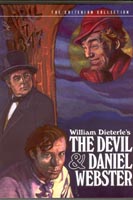

The Devil and Daniel Webster is a "Faust" story with some twists to it. The Faust directed by Murnau is based loosely on a number of "tales" about the Devil and a contract for someone's soul. The film used materials from these folk stories as well as both Marklowe and Goethe. The idea of a scholar who makes the pact with the Devil was echoed in folktales by a number of other people of more "practical" walks of life whose deals with teh Devil were made more identifyable since it was ordinary people who trafficked with the Devil.
The Devil and Daniel Webster is a short story by Stphen Vincent Benet which won the O'Henry Award, and American writer from Bethlehem Pa., educated at Yale. He was born in 1898 and died in 1943. Among his works is the 1929 Pulitzer Prize winning book John Brown's Body
The original story is patriotic and pro-New England. In the course of the trial various American wrongs are addressed (treatment of Indians, racism, slavery) but glossed over and in some instances a reversed opinion is given.
In this version although the time is still set in 1840, the film resonates with 1941 problems.
The story appears also as a one act play, and a folk opera.
Wilhelm or William Dieterlie, the director, was originally an actor in Germany and plays Margarete's brother Valentin in Murnau's Faust, so he has a previous connection with the Devil.
He co-director the famous Midsummers Night's Dream starring James Cagney, Joe E. Brown and Mickey Rooney along with many famous films including The Story of Louis Pasteur, Satan was a Lady, The Life of Emil Zola, Hunchback of Notre Dame, Dr. Ehrlich's Magic Bullet, Portrait of Jennie, Turning Point, Salome, Elephant Walk and many others. The film, peculiarly enough was shot in sequence basically, although Thomas Mitchum, originally cast as Daniel Webster broke his leg in an accident while ridding the buggy and had to be replaced by Edward Arnold. Hence those scene had to be re=shot, although since the biggest scenes for Webster hadn't been filmed yet, it was a lucky thing that it was being filmed in order.
An addition to the short story is the appearance of the Devil's demon, Belle/Bella Dee played by Simone Simon.
AFTER THE FILM
In what ways does the film resemble the early 1940's? The U.S. was just coming out of the depression and the plight of the farmers and their attempt to form a grange would have met with sympathetic ears. The idea of loan sharks and capitalists as "bad guys" would have appealed to many of the pro-unionists.
How does the film differ from that of the Murnau Faust?
Not interested in knowledge, power etc., only wants to be able to make a living working. Stone is a much more "down to earth" guy who has been having a run of bad luck and may lose his farm.
FILM TECHNIQUES
Visual
Use of shadows. Notice especially the way they are used in the indoor shots which appear to have outside lighting.
How does the use of shadow express the changes occurring in Jabez Stone?
How is the first appearances with the Devil shot?
Compare the Devil's entrance(s) with the entrance of Belle/Bella Dee
Special Effects
The film has a number of special effects which are rather low key in the film. Consider the Devil's business card, the and throwing episode, abd the burning of the letter.
Intertextuality:
Sound and Music